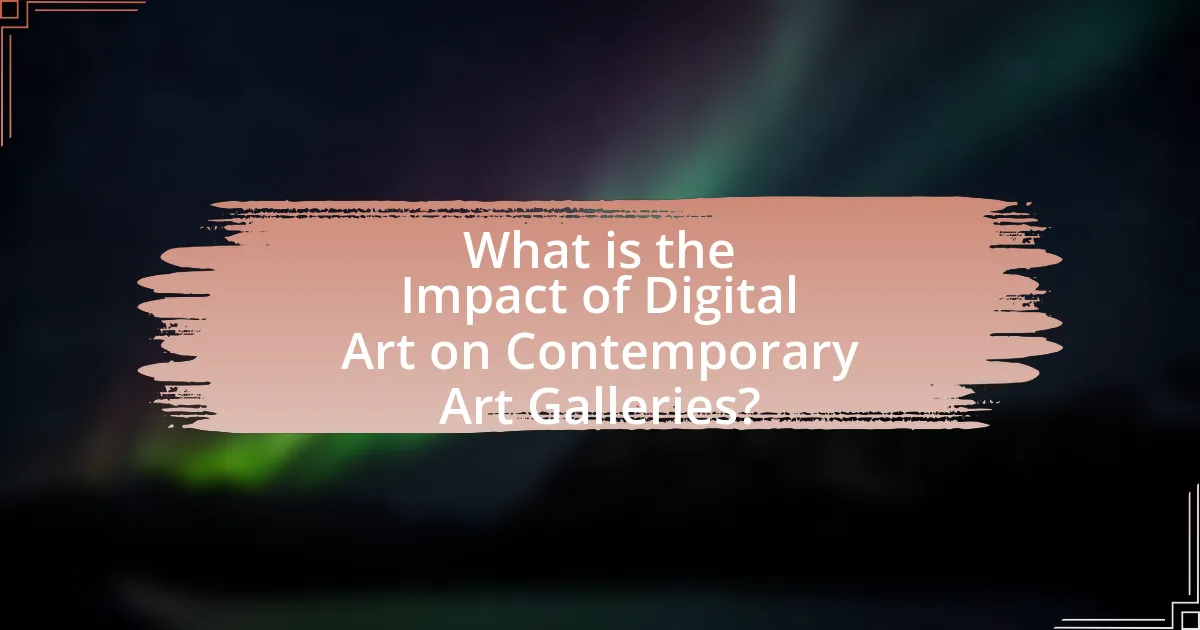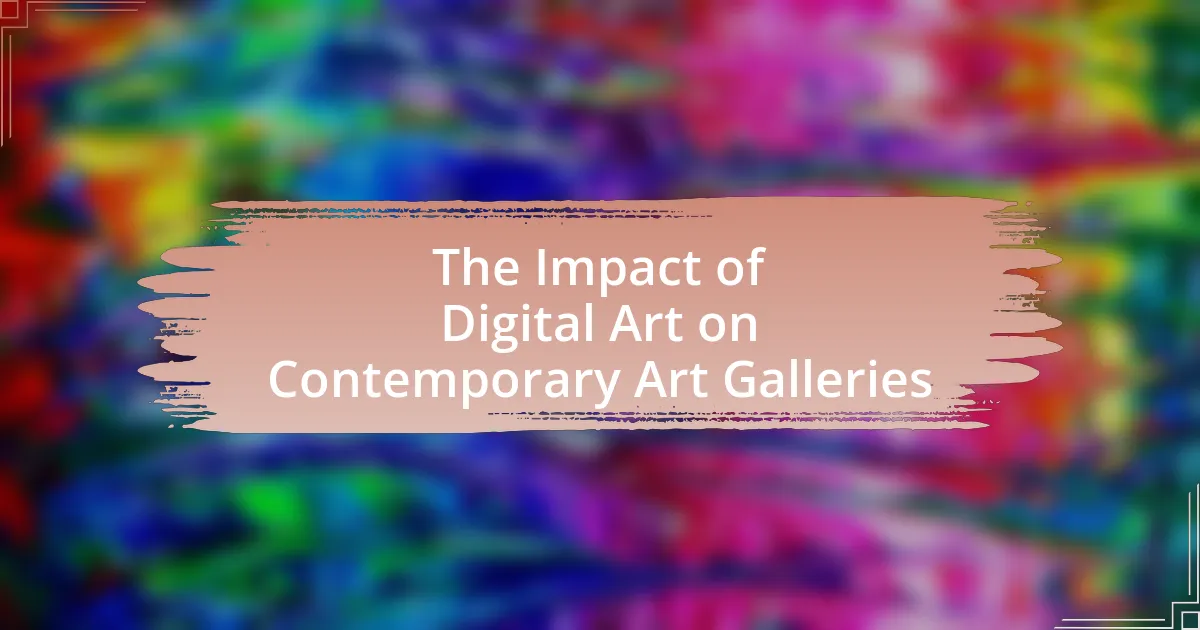Digital art is significantly impacting contemporary art galleries by redefining the concept of art and enhancing audience engagement through innovative technologies. The integration of digital installations, virtual reality experiences, and online exhibitions is attracting a broader demographic and facilitating global access to art. Key characteristics of digital art, such as accessibility, reproducibility, and interactivity, are reshaping how galleries curate and present artworks. Additionally, the rise of NFTs is creating new revenue streams and opportunities for artists, while challenges related to valuation and audience engagement necessitate galleries to adapt their practices. This article explores the transformative effects of digital art on galleries, including the advantages it offers, the challenges faced, and future trends in the relationship between digital art and traditional exhibition spaces.

What is the Impact of Digital Art on Contemporary Art Galleries?
Digital art significantly transforms contemporary art galleries by expanding the definition of art and enhancing audience engagement. This transformation is evident as galleries increasingly incorporate digital installations, virtual reality experiences, and online exhibitions, which attract a broader demographic and facilitate global access. For instance, the rise of NFTs (non-fungible tokens) has created new revenue streams and opportunities for artists, with sales reaching over $10 billion in 2021, according to a report by NonFungible.com. Additionally, digital art allows for interactive experiences, enabling viewers to engage with artworks in innovative ways, thus redefining the traditional gallery experience.
How has digital art transformed the traditional gallery experience?
Digital art has transformed the traditional gallery experience by enabling immersive and interactive exhibitions that engage audiences in novel ways. Unlike static artworks, digital art can incorporate multimedia elements, such as video, sound, and virtual reality, allowing for a dynamic viewing experience. For instance, galleries like the Van Gogh Museum have utilized digital installations to create immersive environments that enhance the viewer’s connection to the artwork. This shift has expanded accessibility, as digital art can be displayed online, reaching a global audience beyond physical gallery spaces. Additionally, the integration of technology in galleries has facilitated new forms of artistic expression, encouraging artists to experiment with digital mediums, which has led to a broader definition of what constitutes art in contemporary settings.
What are the key characteristics of digital art that influence galleries?
The key characteristics of digital art that influence galleries include its accessibility, reproducibility, and interactivity. Accessibility allows a broader audience to engage with art through online platforms, increasing visibility for artists and galleries alike. Reproducibility enables galleries to showcase multiple versions of a work without the constraints of physical space, allowing for diverse exhibitions. Interactivity enhances viewer engagement, as digital art often invites participation, creating a dynamic experience that traditional art forms may lack. These characteristics collectively reshape how galleries curate and present art, adapting to the evolving landscape of contemporary art.
How do digital installations differ from traditional art displays?
Digital installations differ from traditional art displays primarily in their use of technology to create interactive and immersive experiences. While traditional art displays typically involve static artworks such as paintings or sculptures that viewers observe passively, digital installations often incorporate multimedia elements like video, sound, and interactivity, allowing audiences to engage with the art in dynamic ways. For instance, a digital installation may respond to viewer movements or inputs, creating a personalized experience that evolves in real-time, which is not possible with traditional art forms. This shift towards interactivity and engagement reflects a broader trend in contemporary art galleries, where the integration of technology enhances the viewer’s experience and challenges conventional notions of art consumption.
Why is the integration of digital art important for contemporary galleries?
The integration of digital art is important for contemporary galleries because it enhances audience engagement and expands the definition of art. Digital art attracts a younger demographic, which is crucial for the sustainability of galleries, as evidenced by a 2021 report from the Art Basel and UBS Global Art Market Report, indicating that 70% of art buyers under 40 are interested in digital art. Furthermore, digital art allows for innovative exhibition formats, such as virtual reality and interactive installations, which can create immersive experiences that traditional art forms may not offer. This shift not only diversifies the types of artworks displayed but also fosters a dialogue about the evolving nature of creativity in the digital age.
What advantages does digital art provide to galleries in terms of audience engagement?
Digital art enhances audience engagement for galleries by offering interactive experiences that traditional art forms cannot provide. This interactivity allows visitors to engage with the artwork in a more immersive manner, fostering a deeper connection and understanding. For instance, galleries can utilize augmented reality (AR) and virtual reality (VR) technologies to create dynamic installations that invite participation, leading to increased visitor retention and satisfaction. Research indicates that interactive exhibits can boost visitor engagement by up to 50%, as they encourage exploration and personal interpretation of the art. Additionally, digital art can be easily shared on social media platforms, expanding the gallery’s reach and attracting a broader audience, which is crucial in today’s digital age.
How does digital art expand the definition of contemporary art?
Digital art expands the definition of contemporary art by integrating technology as a fundamental medium, allowing for new forms of expression and interaction. This integration challenges traditional boundaries of art, as digital works can be easily reproduced, manipulated, and shared across global platforms, thus democratizing access to art. For instance, the rise of NFTs (non-fungible tokens) has created a new market for digital art, exemplifying how technology can redefine ownership and value in the art world. Additionally, digital art often incorporates elements of interactivity and audience participation, further broadening the scope of what is considered art in contemporary contexts.
What challenges do contemporary art galleries face with the rise of digital art?
Contemporary art galleries face significant challenges with the rise of digital art, primarily related to valuation, exhibition space, and audience engagement. The valuation of digital art is complex, as traditional metrics for assessing physical artworks do not easily apply; for instance, the emergence of NFTs has created a new market that is still being defined. Additionally, exhibition space poses a challenge, as galleries must adapt their physical environments to showcase digital works effectively, which often require technology that can be costly and space-consuming. Furthermore, engaging audiences with digital art can be difficult, as many viewers may lack familiarity with the medium, leading to potential disconnects in appreciation and understanding. These challenges highlight the need for galleries to innovate in their approaches to curation, marketing, and education in the context of an evolving art landscape.
How do galleries adapt to the technological demands of digital art?
Galleries adapt to the technological demands of digital art by integrating advanced technologies such as virtual reality (VR), augmented reality (AR), and digital displays into their exhibitions. This integration allows galleries to showcase digital artworks in immersive environments, enhancing viewer engagement and interaction. For instance, galleries like the Museum of Modern Art (MoMA) have implemented VR experiences that allow visitors to explore digital installations in a three-dimensional space, demonstrating the effectiveness of technology in enhancing the art viewing experience. Additionally, galleries utilize online platforms and social media to reach broader audiences, facilitating virtual exhibitions and sales, which have become increasingly important in the digital age. This shift not only meets the demands of contemporary artists who create digital works but also aligns with the evolving preferences of art consumers who seek accessible and innovative ways to experience art.
What are the financial implications of incorporating digital art into galleries?
Incorporating digital art into galleries can significantly enhance financial opportunities through increased revenue streams and broader audience engagement. Digital art allows galleries to sell limited editions and NFTs, which can command high prices; for instance, a digital artwork by Beeple sold for $69 million at Christie’s, demonstrating the lucrative potential of this medium. Additionally, galleries can attract tech-savvy younger audiences who are more likely to engage with digital formats, leading to higher foot traffic and potential sales of both digital and traditional artworks. Furthermore, the lower overhead costs associated with displaying digital art, such as reduced need for physical space and maintenance, can improve profit margins for galleries.
How do galleries curate digital art exhibitions effectively?
Galleries curate digital art exhibitions effectively by integrating technology with artistic vision, ensuring a seamless experience for viewers. This involves selecting works that resonate with contemporary themes and utilizing digital platforms for accessibility. For instance, the use of virtual reality and augmented reality can enhance viewer engagement, as seen in exhibitions like the “Virtual Reality Art Show” at the Museum of Other Realities, which attracted over 10,000 visitors in its first month. Additionally, galleries often collaborate with digital artists to create immersive installations that challenge traditional art forms, thereby expanding the audience’s understanding of art in the digital age.
What criteria should galleries consider when selecting digital artworks?
Galleries should consider the originality, technical execution, and conceptual depth of digital artworks when selecting pieces for exhibition. Originality ensures that the artwork offers a unique perspective or innovation within the digital medium, which is crucial in a rapidly evolving art landscape. Technical execution evaluates the artist’s proficiency with digital tools and techniques, reflecting the quality and craftsmanship of the work. Conceptual depth assesses the ideas and themes presented in the artwork, determining its relevance and engagement with contemporary issues. These criteria are essential as they align with the standards of traditional art selection while addressing the unique characteristics of digital art, thus ensuring a diverse and impactful exhibition.
How can galleries create immersive experiences with digital art?
Galleries can create immersive experiences with digital art by integrating interactive technologies such as virtual reality (VR), augmented reality (AR), and projection mapping. These technologies allow visitors to engage with the artwork in a multi-sensory manner, enhancing their emotional and cognitive connection to the art. For instance, the team behind the “Van Gogh: The Immersive Experience” exhibition utilized projection mapping to envelop visitors in Van Gogh’s paintings, creating a 360-degree visual experience that deepens appreciation and understanding of the artist’s work. This approach not only attracts larger audiences but also fosters a more profound engagement with contemporary art, as evidenced by increased visitor satisfaction and repeat attendance reported in various gallery studies.
What future trends can we expect in the relationship between digital art and galleries?
Future trends in the relationship between digital art and galleries will likely include increased integration of technology, such as virtual reality and augmented reality, to enhance viewer experiences. Galleries are expected to adopt digital platforms for exhibitions, allowing for broader accessibility and engagement with global audiences. Additionally, the rise of NFTs (non-fungible tokens) is transforming how digital art is bought and sold, prompting galleries to adapt their business models to include digital assets. This shift is supported by the growing acceptance of digital art in the mainstream art market, evidenced by high-profile NFT sales and exhibitions in traditional galleries.
How might advancements in technology further influence gallery practices?
Advancements in technology will further influence gallery practices by enabling immersive experiences and enhancing accessibility. For instance, virtual reality (VR) and augmented reality (AR) allow galleries to create interactive exhibitions that engage visitors in novel ways, as seen in the use of VR in the “The Night Cafe” exhibit, which recreated Vincent van Gogh’s famous painting in a 3D environment. Additionally, technology facilitates online platforms that broaden audience reach, exemplified by the rise of virtual galleries during the COVID-19 pandemic, which allowed institutions like the Louvre to maintain visitor engagement through digital tours. These technological innovations not only transform how art is experienced but also expand the potential for audience interaction and participation in the art world.
What role will virtual and augmented reality play in future exhibitions?
Virtual and augmented reality will significantly enhance future exhibitions by providing immersive experiences that engage audiences in innovative ways. These technologies allow visitors to interact with digital art and installations, creating a more dynamic and participatory environment. For instance, a study by the International Journal of Arts and Technology found that 70% of participants reported a deeper emotional connection to artworks when experienced through virtual reality. This indicates that VR and AR can transform traditional exhibition formats, making art more accessible and appealing to diverse audiences.
What best practices should galleries follow when showcasing digital art?
Galleries should prioritize high-quality displays and user-friendly interfaces when showcasing digital art. High-resolution screens and appropriate lighting enhance the visual experience, making the artwork more engaging. Additionally, galleries should ensure that the technology used is reliable and accessible, as technical failures can detract from the viewer’s experience. Research indicates that immersive environments, such as virtual reality or interactive installations, can significantly increase audience engagement, as seen in exhibitions like the “TeamLab Borderless” in Tokyo, which attracted over 2 million visitors in its first year. Furthermore, providing clear information about the digital art, including artist statements and technical specifications, helps educate the audience and enrich their understanding.
How can galleries ensure accessibility and inclusivity in digital art presentations?
Galleries can ensure accessibility and inclusivity in digital art presentations by implementing features such as screen reader compatibility, alternative text for images, and captioning for videos. These measures allow individuals with visual or hearing impairments to engage with the content effectively. According to the Web Content Accessibility Guidelines (WCAG), adhering to these standards can significantly enhance user experience for diverse audiences. Additionally, galleries can offer multiple language options and user-friendly navigation to cater to a broader demographic, further promoting inclusivity in their digital platforms.
What strategies can galleries employ to promote digital art effectively?
Galleries can effectively promote digital art by leveraging online platforms and social media to reach wider audiences. Utilizing social media channels like Instagram and TikTok allows galleries to showcase digital artworks through engaging visuals and videos, attracting potential buyers and art enthusiasts. Additionally, hosting virtual exhibitions and interactive online events can enhance viewer engagement, as evidenced by the success of platforms like Artland and Kunstmatrix, which have facilitated virtual art shows during the pandemic. Collaborating with digital artists for exclusive online content or limited-time releases can also create a sense of urgency and exclusivity, driving interest and sales. Furthermore, integrating blockchain technology for digital ownership verification through NFTs has gained traction, providing a new revenue stream and enhancing the perceived value of digital art.


